Abstract
The structural stability of γ-boron is investigated using Raman spectra and DFT calculations under high pressures, up to 126 GPa, at ambient temperature. The pressure dependence of all the Raman-active modes of the γ-boron is reported. We also observe amusing changes within the B3g and B1g Raman-active vibrational modes, which result in the phenomenon of first merging and then separating the Raman peaks. In addition to the Raman measurements, the changes in crystal structure and force constants are calculated to reasonably explain the discrepancy between the two Raman modes in response to pressure. The results of the continuous shifts for all Raman modes and the unit-cell parameters, as well as volume with increasing pressure, indicate that there is no structural transformation of γ-boron below this pressure value, with no changes in either symmetry or structure.
1. Introduction
Boron, one of the most fundamental elements in nature, often exists in the form of boron-rich solids, due to its high chemical activity. The first nonmetallic solid in the Periodic Table under ambient conditions makes boron an extraordinarily attractive topic in terms of its physical and chemical properties, as boron-rich solids are one of the most important members of non-metallic superhard materials. However, pure boron has rarely been studied, due to its difficult preparation.
Although the literature suggests that boron exists in many polymorphs [1], only three pure phases are well characterized with definite structures. They are α-B12 [1], β-B106 [2], and γ-B28 [3], all of which have complicated structures dominated by B12 icosahedron clusters. Only three sufficiently localized valence electrons result in boron nonmetallization. However, several theoretical studies have reported that α-B12 and β-B106 should undergo a transformation from non-metal to metal under compression [4,5,6]. It was confirmed that the β-B106 transforms from a nonmetal to a superconductor at about 160 GPa [7]. The high-pressure resistance measurements of α-B12 also demonstrated its pressure-induced superconductivity [8,9]. Nevertheless, from the structural viewpoint, focusing on the phase stability of boron under high pressure is indispensable. The structural stability of α-B12 and β-B106 under pressure has been investigated experimentally and theoretically [10,11,12,13,14,15,16,17,18,19,20]. Unfortunately, the structural stability of γ-B28 at high pressures is still experimentally unsolved, whereas many previous studies have concentrated on the synthesis and phase diagram at high pressure and high temperature (HPHT) [21,22,23,24,25].
Wentorf firstly observed γ-B28 at HPHT in 1965 [26]. In 2009, Oganov et al. determined its structure, as shown in Figure 1 [3]. They concluded that γ-B28 remained stable up to 89 GPa and then transformed into the α-Ga-type phase, which was predicted to be a possible good candidate for the high-pressure metallic phase of boron via ab initio evolutionary crystal structure predictions [27]. Several theoretical and experimental studies have been devoted to the structural stability of γ-B28 under pressure [28,29,30,31,32,33]. However, there are contradictions and controversies in these results. Jiang et al. suggested that the structure of γ-B28 was expected to remain stable up to 40 GPa using first-principle density functional calculations [28]. At the same time, the γ-B28 phase was demonstrated to be stable up to at least 65 GPa, as a result of high-pressure x-ray diffraction (XRD) measurements with Ne or He as a pressure-transmitting medium [29,30,31]. However, Zarechnaya et al. claimed that γ-B28 undergoes an isostructural phase transformation around 40 GPa, based on their Raman spectra and XRD data under high pressure [34]. They reported that both Raman modes of Ag at 380 cm−1 and B3g at 470 cm−1 undergo hardening and then softening with increasing pressure, and the modes at 480 cm−1 and 810 cm−1 split at approximately 40 GPa [34]. However, Oganov et al. considered that the results of Zarechnaya et al. did not provide sufficient evidence to support an isostructural phase transition due to the contradiction of their XRD data with theoretical works and the absence of a physically reasonable mechanism of the “isostructural transformation” [35].

Figure 1.
Structure of γ-B28 from different directions of (a) a axis, (b) b axis and (c) c axis, respectively. The boron atoms in B12 icosahedra are marked in green while those in B2 dumbells are marked in orange.
Boron is a light element and a very poor scatterer because of the low scattering cross-section of boron atoms. Thus, it is very difficult to measure XRD of boron at high pressure. This makes studying the behavior of boron under high pressure extremely difficult. γ-B28 has an extraordinary complicated structure with an utterly unique and easily distinguishable Raman spectrum [36]. Moreover, phase transitions are often associated with changes in crystal structure and symmetry, which can be directly demonstrated by Raman spectroscopy. Therefore, Raman spectroscopy is the most convenient and powerful method to research the properties of γ-B28 under high pressure. However, experimental information about the high-pressure Raman spectra of γ-B28 is limited. Here, we present the results of the high-pressure Raman spectroscopy of γ-B28 up to 126 GPa at room temperature.
2. Experimental Details
β-boron (β-B106, rhombohedral, space group R-3m; purity at. 99.9999%) was employed as the raw material to synthesize polycrystalline aggregates of gamma phase boron (γ-B28, orthorhombic with space group Pnnm) at 10 GPa and at high temperatures above 2000 K. We synthesized the γ-boron in three steps. In the 1st step, β-boron and Ne as pressure-transmitting medium were loaded into the chamber of DAC; in the 2nd step, β-boron is loaded to 10 GPa; in the 3rd step, laser heating was performed to synthesize the γ-boron, and then it was cooled to room temperature. To check the quality of the samples after synthesis, we measured the Raman spectra of different regions of the sample. The absence of other Raman modes of impurities and the high intensity of the Raman peaks obtained in a very short measurement time demonstrated the high quality of the samples.
High-pressure experiments were carried out using a diamond anvil cell (DAC) with 100 μm diameter culets, as shown in Figure 2a. Rhenium was used as gasket between the diamonds, which was preindented to a thickness of 20 μm; then, a hole with diameter of 70 μm was drilled in the center as sample chamber. The β-boron and ruby particles were packed into the chamber. The pressure blow 80 GPa was measured in situ from the calibrated shift of the ruby R1 fluorescent line [37], whereas the pressure above 80 GPa was calibrated with stressed diamond Raman edge, defined as the frequency that minimized dI/dν [38,39]. In this work, the error in pressure calibration was approximately ±1 GPa. Neon was loaded as a pressure-transmitting medium (PTM). A one-side laser-heating device was employed to provide a high-temperature environment for boron during the experiment. A near-infrared laser (YAG, 1064 nm) was utilized to heat the sample at a maximum powder of 11 W. In the experiment, we used a confocal microscope Raman spectrometer system equipped with a stigmatic spectrometer and a multichannel air-cooled CCD detector to collect the Raman scattering spectra. The groove density of the grating, the focal length of the spectrometer, and the spectral resolution of the instrument were, respectively, 600 lines/mm, 800 mm, and 0.5 cm−1. An He-Ne laser (632.8 nm, power of 7 mW) was used for an excitation source. After laser heating, the pressure stabilized at 13.5 GPa. Then, the pressure in the cell was pressurized to 126.2 GPa at room temperature. The Raman spectra were measured at each pressure step, and similar experiments were run three times.
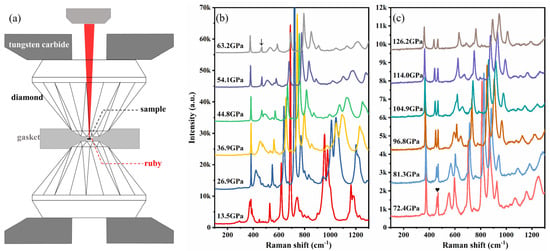
Figure 2.
(a) The scheme of the diamond anvil cell (DAC). (b,c) Raman spectra of γ-B28 compressed in a neon pressure-transmitting medium in a diamond anvil cell. Raman spectra at different pressures are displayed in different colors.
3. First Principle Calculations
Crystal structures under high pressure were performed using the periodic plane-wave density functional theory (DFT) method with the projected-augmented wave (PAW) method implemented in the VASP code. Perdew–Burke–Ernzerhof (PBE) was used for the exchange-correlation potentials. The energy cutoff for the plane-wave basis was set to 500 eV, and the Brillouin zone was sampled by a Monkhorst–Pack grid of 12 × 12 × 12. The self-consistent convergence criteria of energy were set to 1 × 10−6 for ionic relaxations, and all atoms were relaxed until the forces were less than 0.01 eV/Å.
4. Results and Discussion
To investigate the structural stability of γ-boron under high pressure, we performed in situ Raman spectroscopy measurements under high pressures up to 126 GPa at ambient temperature. The pre-synthesized γ-boron samples demonstrated high quality, and, consequently, many weak Raman modes could also be detected. Figure 2b,c shows the evolution of the Raman modes of γ-boron between 100 cm−1 and 1300 cm−1 under high pressure up to 126 GPa at room temperature. Moreover, the pressure dependence of the frequencies of different Raman-active modes is displayed in Figure 3. We measured the pressure dependence of 23 Raman modes. Compared to previous works [34,40], one mode at approximately 500 cm−1, marked as “BP”, at high pressure could not be assigned; another mode could not be determined, and its type (B2g or B3g) was noted as “Bα”, as shown in Figure 3. All Raman modes of γ-boron smoothly shifted with increasing pressure. With loading compression, all Raman modes above 500 cm−1 remained in blueshift. However, the Ag mode at 380 cm−1 first shifted towards higher frequencies and then became soft at high pressures, as shown in Figure 4. The agreement between our results and those previously published [34] was quite good.
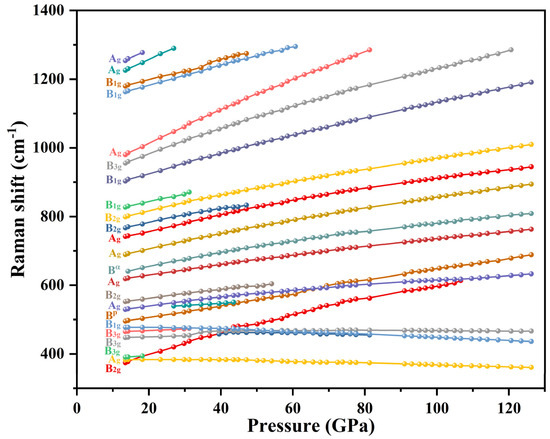
Figure 3.
Variation in the positions of Raman peaks of γ-B28 as a function of pressure. Different Raman modes are displayed in different colors.
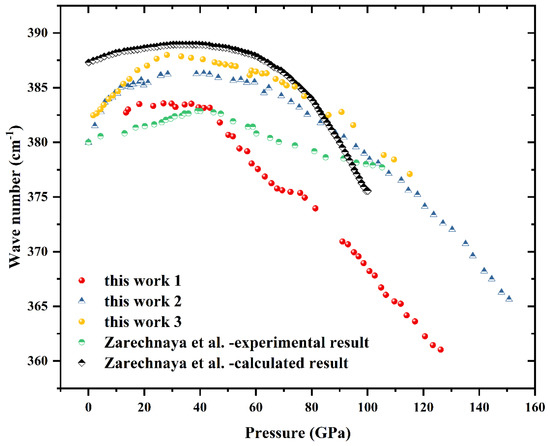
Figure 4.
Pressure dependence of the Ag Raman mode; the results of this work and Zarechnaya et al. [34] are represented by scatters of different colors and shapes.
Next, we concentrated on detailed variations in some Raman modes, especially the Raman modes between 400 cm−1 and 500 cm−1, in which some peaks “split” visibly at 63 GPa, marked by an arrow in Figure 2b. Figure 5 shows the evolution process of Raman modes between 340 cm−1 and 500 cm−1 during compression by fitting the Raman spectrum in this frequency region with the Gaussian-LorenCross function and linear baseline using Origin PeakFit. As observed in Figure 5a, the lattice mode at 374 cm−1 displays a broad peak and a fast blueshift with increasing pressure, overlapping with the B3g mode at 23.2 GPa, and then lifts the background of B3g and B1g modes with the further loading as shown in Figure 5b. Below the pressure of 18 GPa, the three Raman modes of B3g (447 cm−1), B3g (465 cm−1) and B1g (477 cm−1) are evidently distinguishable, as seen in the Raman spectra of Figure 5b. In the process of pressurization from 13.5 GPa, the Raman modes B3g (447 cm−1) and B3g (465 cm−1) move to high wavenumbers, whereas B1g (477 cm−1) shifts in the opposite direction. Above 23GPa, the B3g (465 cm−1) begins to merge into the B1g (477 cm−1). When the pressure reaches approximately 31GPa, B3g (465 cm−1) and B1g (477 cm−1) are completely degenerate, causing the relative strength of B1g (477 cm−1) to increase, whereas B3g (465 cm−1) becomes no longer measurable. At this pressure, the intensity of B1g (477 cm−1) is stronger than that of B3g (447 cm−1). Figure 5c displays the pressure dependences of the three Raman modes frequencies up to 30 GPa.
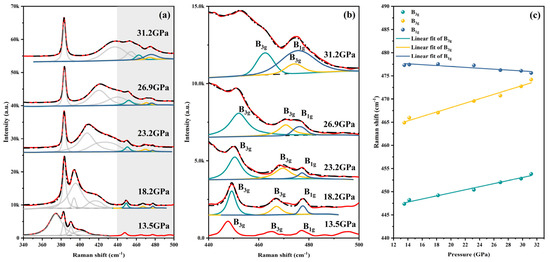
Figure 5.
(a) The evolution process during compression. (b) is the gray area in (a), red solid lines are our experimental data, black dash dot lines represent the fitting curves, and the individual peaks are marked by green (B3g), yellow (B3g) and blue (B1g) respectively. (c) The positions of these three modes (B3g, B3g, and B1g) as a function of pressure up to 30 GPa.
Figure 6 shows the evolution of the B3g and B1g modes between 400 cm−1 and 500 cm−1 from 30 GPa to 126 GPa. For this wavenumber region, in addition to the two broad peaks of the B2g and Ag modes’ fast sweep, only the B3g and B1g modes remain in the pressure region. The relationship between the shifts of these two modes with pressure up to 126 GPa is shown in Figure 7. Under compression, the B3g and B1g modes keep the blueshift and redshift, respectively, and cross at 54 GPa. Around the pressure at 54 GPa, a single Raman peak is observed due to overlap of the two modes, but they are distinguishable based on the decomposition of the spectrum, as displayed in Figure 6a,b. At a pressure of 91 GPa, B3g and B1g are completely separated. With further loading compression, the B3g and B1g modes continue to move monotonously.
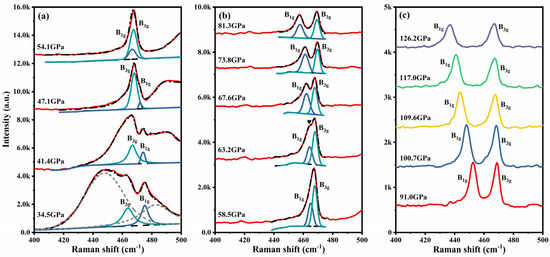
Figure 6.
The process of (a) merging first and (b,c) then separating of B3g and B1g modes with pressure from 30 GPa to 126 GPa. In (a) and (b), red solid lines are our experimental data, black dash dot lines represent the fitting curves, and the individual peaks are marked by green (B3g), and blue (B1g) respectively.

Figure 7.
The relationship between the displacements of these two modes (B3g and B1g) with pressure from 30 GPa to 126 GPa. The green, pink, and blue areas are the pressure ranges where the two peaks begin to merge, have been merged, and, finally, begin to separate, respectively [34].
Similar phenomena to B3g and B1g can also be discovered in other Raman modes, such as BP (495 cm−1) and Ag (529 cm−1) at 58.5 GPa, as shown in Figure 8. Both peaks remain blueshifted under pressure at very different rates. At the same time, BP is more sensitive to pressure, and BP merges into Ag above 60 GPa. Starting from 68 GPa, the relative positions of BP and Ag will be reversed. BP could only be recognized again on the Raman spectrum once the pressure had been loaded to 91 GPa.

Figure 8.
(a) Raman spectra taken at pressures and (b) positions as a function of pressure of BP and Ag modes from 58.5 GPa to 91 GPa. Red solid lines are our experimental data, black dash dot lines represent the fitting curves, and the individual peaks are marked by green (BP) and blue (Ag) respectively.
Our results indicate that no new peaks appear, and all Raman modes are continuously shifted up to 126 GPa. In this pressure range, neither the symmetry nor the structure change was detected. It is controversial that Zarechnaya et al. regarded the softening of the Ag Raman mode at 380 cm−1 under high pressure as evidence of an isostructural phase transition. In the work of Isaac F. Silvera and S.J. Jeon in 1992 [41], they used an established theory of Raman-active modes to investigate the high-pressure softening of the Raman-active vibron of hydrogen and deuterium. They showed that the Raman frequency was affected by both the density-dependent intramolecular potential in the solid and the intermolecular potential, and the softening of the Raman mode was due to the intermolecular potential. Therefore, the softening of Ag Raman mode under high pressure was potentially caused by the intermolecular potential varying with pressure rather than the isostructural phase transition. In previous work [34], the Raman mode splitting observed at approximately 40–45 GPa was considered as characteristic of the isostructural phase transition. This was due to the different shift rates of the two Raman modes of B3g (447 cm−1) and B1g (477 cm−1) with increasing pressure, which resulted in the phenomenon of merging first and then separating. This fact suggested that there was no phase transformation of γ-boron under pressures up to 126 GPa, and no new high-pressure phase was generated.
Despite the complicated structure of γ-boron, we proposed a model to explain the above amusing phenomenon. The Raman modes B1g and B3g correspond to the tilts of the B12 icosahedron around the c-axis and a-axis, respectively [34]. As displayed in Figure 9a, two B12 icosahedrons are connected by a B2 dumbbell. When two B12 icosahedrons tilt around the c-axis, they will drive the two boron atoms of the B2 dumbbell to stretch along the bond direction. Figure 9c displays the tilt of the B12 icosahedron around the a-axis, which responds to the B3g mode. In contrast, the inclination of B12 icosahedron makes the B2 dumbbell swing in a direction perpendicular to its plane, which is very difficult. The B2 dumbbell limits the tilt of the B12 icosahedron and even makes it less affected by compression. Therefore, the B3g mode has a very weak response to pressure, with only a slight and negligible blueshift. If a B12 icosahedron is equivalent to an atom, the complex structure in Figure 9a can be simplified to a four-atom system, as shown in Figure 9b.

Figure 9.
The tilts of the B12 icosahedron around the c-axis (a) and a-axis (c), which respond to the B1g and B3g mode, respectively. (b) displays the four-atom system. The boron atoms in B12 icosahedra are marked in green while those in B2 dumbells are marked in orange.
In this four-atom system, atoms 1 and 4 are icosahedrons, whereas atoms 2 and 3 are single boron atoms. The lengths of the bonds between 1 and 2 and 3 and 4 are the same, which is r. The bond between 2 and 3 is longer, which is R. The bond angles (123) and (234) are also the same, which is ϕ. The dihedral angle between the planes of atoms (123) and (234) is zero because four atoms are located in one plane.
To make it easier to investigate the amusing behavior of the B1g mode, the internal coordinates were used to analyze the vibration of the 4-atom system. For a system of N atoms, the distance between atoms, the bond angle between chemical bonds, or the change in both can be used as a set of 3N-6 (for linear molecules, 3N-5) internal coordinates, i.e., the coordinates are not affected by the translational and rotational motion of the molecule as a whole; thus, it is a more advanced method for studying vibration. In the above 4-atom system, in addition to the dihedral angle (no change), there are five internal coordinates, which are St(t = 1,2,3,4,5), as shown in Figure 9b.
The internal coordinates St can be expressed in the following form [42]
where the point in the formula represents the scalar product of two vectors. The physical meaning of the vector stα is that only the α atom deviates from the equilibrium position; the direction of stα is a given position shift of the α atom, which is the direction of the maximum increase in St; and the value of stα is equal to the increase in St of the atom due to the unit displacement in the most effective direction. In this way, a given internal coordinate St is characterized by a set of vectors stα, one for each atom t.
In the 4-atom system, stα can be expressed [43]:
The potential energy of vibration can be expressed as [44]
The kinetic energy matrix can be given by [43]
where the point in the formula represents the scalar product of two vectors, and is the reciprocal of the mass of the atom to which α refers. Each pair of internal coordinates St and have an element , and this form has the advantage that it requires no coordinate system.
According to the above equation, the G matrix of the 4-atom system can be obtained:
where .
If the potential energy is also expressed by the same internal coordinates, then [44]
where is the force constant; therefore, it has the form
where fr is the r bond-stretching force constant; fR is the R bond-stretching force constant; frR is the force constant for the interaction between bonds r and R; frϕ is the force constant for the interaction between bond r and bond angle ϕ123 or ϕ234; fRϕ is the force constant for the interaction between the bond R and bond angle ϕ123 or ϕ234; and fϕ is the force constant for the interaction between bond angle ϕ123 and ϕ234.
The secular equation can be obtained from the vibration problem and Newton’s equation of motion [44]:
where E is the unit matrix, , and ν is the vibration frequency:
The evolution of the crystal structures of γ-B28 under high pressure (at 1 atm, 10 GPa, 20 GPa, 30 GPa, 40 GPa, 50 GPa, 60 GPa, 70 GPa, 80 GPa, 90 GPa, and 100 GPa) were performed via first principles. The unit cell parameters of γ-boron (a = 5.0426 Å, b = 5.6105 Å, c = 6.9251 Å) obtained through DFT calculations at ambient pressure were close to the experimental data reported by Oganov et al. (a = 5.0544 Å, b = 5.6199 Å and c = 6.9873 Å) [3]. Therefore, the structural parameters r, R, and ϕ under high pressures could be obtained. Figure 10a displays the decrease in r, R, and ϕ with pressure up to 100 GPa. Under certain pressure, the matrix G is a constant matrix because of the known r, R, ϕ, m, and M. Iterate repeatedly the force constants fr, fR, frR, frϕ, fRϕ, and fϕ. According to Equations (6) and (7), the vibration frequency under this pressure could be calculated. Equal the calculated value to the experimental frequency value to achieve convergence to obtain a set of force constants under pressure. Moreover, the force constants under pressures could be obtained. Figure 10b shows the force constants as a function of pressure. All force constants increase with increasing pressure, except that fϕ remains basically unchanged. To verify the accuracy of the calculated results, another Raman mode was simulated with the calculated force constants. The result was consistent with the experimentally obtained Ag mode, as shown in Figure 10c. In conclusion, the abnormal behavior of the B1g Raman mode under pressure was caused by changes in the crystal structures and force constants. During the process of pressurization, the reduced bond length and bond angle with increased force constants made it more difficult for two B12 icosahedrons to drive the two boron atoms of the B2 dumbbell to stretch along the bond direction, resulting in the redshift of the B1g mode with increasing pressure.

Figure 10.
(a) the bond length R and r, bond angle ϕ, and (b) force constants varies as functions of pressure. (c) Comparison of the calculated Raman mode and the experimental Ag mode.
Furthermore, the unit-cell parameters and relative volume of γ-boron as a function of pressure could also be obtained through DFT calculations. Figure 11 shows the curves of the unit-cell parameters (a, b, and c) and relative volume with pressure up to 100 GPa. The unit-cell parameters (a, b, and c) of γ-Boron varied almost continuously from 1 atm to 100 GPa. Additionally, the volume of γ-Boron also decreased smoothly with pressure. Apparently, the compression behavior of the γ-Boron was almost the same at pressures from 1 atm up to 100 GPa. The continuous variations in the unit-cell parameters, volume (Figure 11), and bond length, as well as bond angle (Figure 10a), indicated no structural transformations in γ-boron under high pressure.
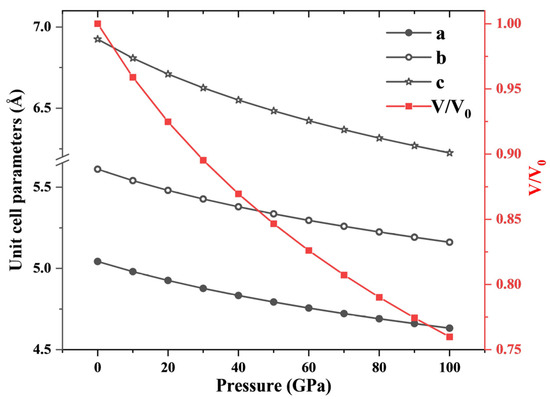
Figure 11.
The unit-cell parameters and relative volume of γ-boron as a function of pressure.
5. Conclusions
We synthesized γ-boron at HPHT and reported its Raman spectra at pressures up to 126 GPa at room temperature. The details of the evolution of the Raman spectrum with pressure were investigated, especially the Raman modes between 400 cm−1 and 500 cm−1, in which some peaks “split” intuitively at 63 GPa. All Raman modes changed continuously with increasing pressure. The Raman mode “splitting” observed at high pressure was actually due to the different direction and rate of shift of the two Raman modes B1g and B3g under pressure, which resulted in the phenomenon of merging first and then separating. Then, we proposed a model to explain the above amusing phenomenon. B1g and B3g corresponded to the tilts of the B12 icosahedron around the c-axis and a-axis, respectively. The crystal structures of γ-B28 under high pressure were calculated via first principles. The responses of the force constants to pressures were calculated by the method of internal coordinates, which resulted in the redshift of the B1g mode with increasing pressure. However, the influence of pressure on the B3g mode was limited, with only a negligible blueshift. In addition, the unit-cell parameters (a, b, and c) and the volume of γ-Boron varied almost continuously from 1 atm to 100 GPa. The results of the continuous shifts for all Raman modes and the unit-cell parameters as well as volume with increasing pressure indicated that the γ-boron had no structural transformation under pressures up to 126 GPa, and no new high-pressure phase was generated.
Author Contributions
Conceptualization, C.Z. and D.M.; methodology, C.Z., D.M., X.L. and J.W.; software, J.W., X.S.; validation, C.Z., D.M. and Z.Z.; formal analysis, Z.Z.; investigation, X.L.; resources, Z.W.; data curation, D.M. and R.D.; writing—original draft preparation, C.Z.; writing—review and editing, C.Z. and D.M.; visualization, C.Z., D.M. and Z.Z.; supervision, Z.Z.; project administration, Z.Z.; funding acquisition, Z.Z. All authors have read and agreed to the published version of the manuscript.
Funding
This work is supported by the Frontier Scientific Research Program of Deep Space Exploration Laboratory, under grant No. 2022-QYKYJH-HXYF-019; the National Natural Science Foundation of China (No. 12074360); and the project of National Key Laboratory of Shock Wave and Detonation Physics (No. JCKYS2022212008).
Data Availability Statement
All data that support the findings of this study are available from the corresponding author upon reasonable request.
Conflicts of Interest
The authors declare no competing financial interest.
References
- Douglas, B.; Ho, S.-M. Structure and Chemistry of Crystalline Solids; Springer: New York, NY, USA, 2006. [Google Scholar]
- Hughes, R.E.; Kennard, C.H.L.; Sullenger, D.B.; Weakliem, H.A.; Sands, D.E.; Hoard, J.L. The Structure of Β-Rhombohedral Boron. J. Am. Chem. Soc. 1963, 85, 361–362. [Google Scholar] [CrossRef]
- Oganov, A.R.; Chen, J.; Gatti, C.; Ma, Y.; Ma, Y.; Glass, C.W.; Liu, Z.; Yu, T.; Kurakevych, O.O.; Solozhenko, V.L. Ionic High-Pressure Form of Elemental Boron. Nature 2009, 457, 863–867. [Google Scholar] [CrossRef] [PubMed]
- Zhao, J.; Lu, J.P. Pressure-Induced Metallization in Solid Boron. Phys. Rev. B 2002, 66, 092101. [Google Scholar] [CrossRef]
- Haussermann, U.; Simak, S.I.; Ahuja, R.; Johansson, B. Metal-Nonmetal Transition in the Boron Group Elements. Phys. Rev. Lett. 2003, 90, 065701. [Google Scholar] [CrossRef]
- Shirai, K.; Dekura, H.; Yanase, A. Electronic Structure and Electrical Resistivity of A-Boron under High Pressure. J. Phys. Soc. Jpn. 2009, 78, 084714. [Google Scholar] [CrossRef]
- Eremets, M.I.; Struzhkin, V.V.; Mao, H.; Hemley, R.J. Superconductivity in Boron. Science 2001, 293, 272–274. [Google Scholar] [CrossRef]
- Kaneshige, M.; Hirayama, S.; Yabuuchi, T.; Matsuoka, T.; Shimizu, K.; Mita, Y.; Hyoudo, H.; Kimura, K. Measurement of Electrical Resistance and Raman Spectrum of A-Boron under High Pressure. J. Phys. Soc. Jpn. 2007, 76, 19–20. [Google Scholar] [CrossRef]
- Shimizu, K.; Kaneshige, M.; Hashimoto, Y.; Nagatochi, T.; Hyodo, H.; Kimura, K. Superconductivity in A-Boron at Mbar Pressure. Phys. C Supercond. Appl. 2010, 470, S631–S632. [Google Scholar] [CrossRef]
- Vast, N.; Baroni, S.; Zerah, G.; Besson, J.M.; Polian, A.; Grimsditch, M.; Chervin, J.C. Lattice Dynamics of Icosahedralα-Boron under Pressure. Phys. Rev. Lett. 1997, 78, 693–696. [Google Scholar] [CrossRef]
- Masago, A.; Shirai, K.; Katayama-Yoshida, H. Crystal Stability Ofα- Andβ-Boron. Phys. Rev. B 2006, 73, 104102. [Google Scholar] [CrossRef]
- Shang, S.; Wang, Y.; Arroyave, R.; Liu, Z.-K. Phase Stability Inα- Andβ-Rhombohedral Boron. Phys. Rev. B 2007, 75, 092101. [Google Scholar] [CrossRef]
- Polian, A.; Chervin, J.C.; Munsch, P.; Gauthier, M. A-Boron at Very High Pressure: Structural and Vibrational Properties. J. Phys. Conf. Ser. 2008, 121, 042017. [Google Scholar] [CrossRef]
- Parakhonskiy, G.; Vtech, V.; Dubrovinskaia, N.; Caracas, R.; Dubrovinsky, L. Raman Spectroscopy Investigation of Alpha Boron at Elevated Pressures and Temperatures. Solid State Commun. 2013, 154, 34–39. [Google Scholar] [CrossRef]
- Chuvashova, I.; Bykova, E.; Bykov, M.; Svitlyk, V.; Gasharova, B.; Mathis, Y.-L.; Caracas, R.; Dubrovinsky, L.; Dubrovinskaia, N. High-Pressure Behavior of A-Boron Studied on Single Crystals by X-Ray Diffraction, Raman and Ir Spectroscopy. J. Solid. State Chem. 2017, 245, 50–60. [Google Scholar] [CrossRef]
- Pokatashkin, P.A.; Korotaev, P.Y.; Yanilkin, A.V. Amorphization Inα-Boron: A Molecular Dynamics Study. Phys. Rev. B 2017, 95, 064113. [Google Scholar] [CrossRef]
- Sanz, D.N.; Loubeyre, P.; Mezouar, M. Equation of State and Pressure Induced Amorphization of Beta-Boron from X-Ray Measurements up to 100 Gpa. Phys. Rev. Lett. 2002, 89, 245501. [Google Scholar] [CrossRef] [PubMed]
- Ma, Y.; Prewitt, C.T.; Zou, G.; Mao, H.-k.; Hemley, R.J. High-Pressure High-Temperature X-Ray Diffraction of Β-Boron to 30 Gpa. Phys. Rev. B 2003, 67, 174116. [Google Scholar] [CrossRef]
- Siberchicot, B. Ab Initioequation of State Ofα- Andβ-Boron: Possible Amorphization Ofβ-Boron under High Pressure. Phys. Rev. B 2009, 79, 224101. [Google Scholar] [CrossRef]
- An, Q.; Morozov, S.I. Brittle Failure of Β- and Τ-Boron: Amorphization under High Pressure. Phys. Rev. B 2017, 95, 064108. [Google Scholar] [CrossRef]
- Shirai, K.; Masago, A.; Katayama-Yoshida, H. High-Pressure Properties and Phase Diagram of Boron. Phys. Status Solidi 2007, 244, 303–308. [Google Scholar] [CrossRef]
- Parakhonskiy, G.; Dubrovinskaia, N.; Bykova, E.; Wirth, R.; Dubrovinsky, L. Experimental Pressure-Temperature Phase Diagram of Boron: Resolving the Long-Standing Enigma. Sci. Rep. 2011, 1, 96. [Google Scholar] [CrossRef] [PubMed]
- Qin, J.; Irifune, T.; Dekura, H.; Ohfuji, H.; Nishiyama, N.; Lei, L.; Shinmei, T. Phase Relations in Boron at Pressures up to 18 Gpa and Temperatures up to 2200 °C. Phys. Rev. B 2012, 85, 014107. [Google Scholar] [CrossRef]
- Solozhenko, V.L.; Kurakevych, O.O. Equilibrium P-T Phase Diagram of Boron: Experimental Study and Thermodynamic Analysis. Sci. Rep. 2013, 3, 2351. [Google Scholar] [CrossRef] [PubMed]
- Shirai, K. Phase Diagram of Boron Crystals. Jpn. J. Appl. Phys. 2017, 56, 05FA06. [Google Scholar] [CrossRef]
- Wentorf, R.H., Jr. Boron: Another Form. Science 1965, 147, 49–50. [Google Scholar] [CrossRef]
- Ma, Y.; Tse, J.S.; Klug, D.D.; Ahuja, R. Electron-Phonon Coupling Ofα−Gaboron. Phys. Rev. B 2004, 70, 214107. [Google Scholar] [CrossRef]
- Jiang, C.; Lin, Z.; Zhang, J.; Zhao, Y. First-Principles Prediction of Mechanical Properties of Gamma-Boron. Appl. Phys. Lett. 2009, 94, 191906. [Google Scholar] [CrossRef]
- Zarechnaya, E.Y.; Dubrovinsky, L.; Dubrovinskaia, N.; Filinchuk, Y.; Chernyshov, D.; Dmitriev, V.; Miyajima, N.; El Goresy, A.; Braun, H.F.; Van Smaalen, S.; et al. Superhard Semiconducting Optically Transparent High Pressure Phase of Boron. Phys. Rev. Lett. 2009, 102, 185501. [Google Scholar] [CrossRef]
- Isaev, E.I.; Simak, S.I.; Mikhaylushkin, A.S.; Vekilov, Y.K.; Zarechnaya, E.Y.; Dubrovinsky, L.; Dubrovinskaia, N.; Merlini, M.; Hanfland, M.; Abrikosov, I.A. Impact of Lattice Vibrations on Equation of State of the Hardest Boron Phase. Phys. Rev. B 2011, 83, 132106. [Google Scholar] [CrossRef]
- Godec, Y.L.; Kurakevych, O.O.; Munsch, P.; Garbarino, G.; Solozhenko, V.L. Equation of State of Orthorhombic Boron, -B28. Solid. State Commun. 2009, 149, 1356–1358. [Google Scholar] [CrossRef]
- Le Godec, Y. Comparative Review of Theoretical and Experimental Equations of State of Orthorhombic Boron Γ-B28. J. Superhard Mater. 2011, 33, 388–393. [Google Scholar] [CrossRef]
- Oganov, A.R. Discovery of Γ-B28, a Novel Boron Allotrope with Partially Ionic Bonding. MRS Online Proc. Libr. 2011, 1307, 201. [Google Scholar] [CrossRef]
- Zarechnaya, E.; Dubrovinskaia, N.; Caracas, R.; Merlini, M.; Hanfland, M.; Filinchuk, Y.; Chernyshov, D.; Dmitriev, V.; Dubrovinsky, L. Pressure-Induced Isostructural Phase Transformation Inγ-B28. Phys. Rev. B 2010, 82, 184111. [Google Scholar] [CrossRef]
- Oganov, A.R.; Solozhenko, V.L.; Gatti, C.; Kurakevych, O.O.; Le Godec, Y. The High-Pressure Phase of Boron, Γ-B28: Disputes and Conclusions of 5 Years after Discovery. J. Superhard Mater. 2011, 33, 363–379. [Google Scholar] [CrossRef]
- Yu Zarechnaya, E.; Dubrovinsky, L.; Dubrovinskaia, N.; Miyajima, N.; Filinchuk, Y.; Chernyshov, D.; Dmitriev, V. Synthesis of an Orthorhombic High Pressure Boron Phase. Sci. Technol. Adv. Mater. 2008, 9, 044209. [Google Scholar] [CrossRef] [PubMed]
- Mao, H.K.; Xu, J.; Bell, P.M. Calibration of the Ruby Pressure Gauge to 800 Kbar under Quasi-Hydrostatic Conditions. J. Geophys. Res. 1986, 91, 4673–4676. [Google Scholar] [CrossRef]
- Akahama, Y.; Kawamura, H. High-Pressure Raman Spectroscopy of Diamond Anvils to 250 gpa: Method for Pressure Determination in the Multimegabar Pressure Range. J. Appl. Phys. 2004, 96, 3748–3751. [Google Scholar] [CrossRef]
- Dalladay-Simpson, P.; Howie, R.T.; Gregoryanz, E. Evidence for a New Phase of Dense Hydrogen above 325 Gigapascals. Nature 2016, 529, 63–67. [Google Scholar] [CrossRef]
- Zarechnaya, E.Y.; Dubrovinskaia, N.; Dubrovinsky, L. Polarized Raman Spectroscopy of High-Pressure Orthorhombic Boron Phase. High Press. Res. 2009, 29, 530–535. [Google Scholar] [CrossRef]
- Silvera, I.F.; Jeon, S.J.; Lorenzana, H.E. Pressure Dependence of the Vibron Modes in Solid Hydrogen and Deuterium. Phys. Rev. B Condens. Matter 1992, 46, 5791–5794. [Google Scholar] [CrossRef]
- Wilson, E.B. Some Mathematical Methods for the Study of Molecular Vibrations. J. Chem. Phys. 1941, 9, 76–84. [Google Scholar] [CrossRef]
- Decius, J.C. A Tabulation of General Formulas for Inverse Kinetic Energy Matrix Elements in Acyclic Molecules. J. Chem. Phys. 1948, 16, 1025–1034. [Google Scholar] [CrossRef]
- Wilson, E.B. A Method of Obtaining the Expanded Secular Equation for the Vibration Frequencies of a Molecule. J. Chem. Phys. 1939, 7, 1047–1052. [Google Scholar] [CrossRef]
Disclaimer/Publisher’s Note: The statements, opinions and data contained in all publications are solely those of the individual author(s) and contributor(s) and not of MDPI and/or the editor(s). MDPI and/or the editor(s) disclaim responsibility for any injury to people or property resulting from any ideas, methods, instructions or products referred to in the content. |
© 2023 by the authors. Licensee MDPI, Basel, Switzerland. This article is an open access article distributed under the terms and conditions of the Creative Commons Attribution (CC BY) license (https://creativecommons.org/licenses/by/4.0/).